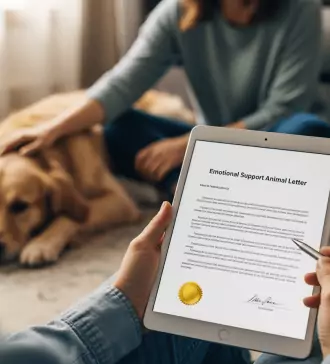

Step-by-Step Guide To Obtaining An ESA Letter
by Nida Hammad
Last updated: November 4, 2025
Verified and Approved by:
Angela Morris,
MSW, LCSW
Fact Checked

-
- Research and choose a licensed mental health professional who can provide an evaluation and write an ESA letter if needed.
- Schedule an appointment with the chosen mental health professional to discuss your mental health struggles and how support from an emotional support animal can be beneficial.
- Attend the evaluation session and openly discuss your mental health struggles and the potential benefits of having an emotional support animal.
- If there is a legitimate need for an emotional support animal, the mental health professional will provide an ESA letter stating the need for the animal as a form of support.
So, you’re thinking about getting an Emotional Support Animal (ESA) letter, huh? Well, you’ve come to the right place! Whether you’re dealing with anxiety, depression, or any other mental health condition, an ESA can provide you with the love and support you need to navigate life’s ups and downs.
But before you can snuggle up with your furry friend, there are a few steps you need to take. Don’t worry, we’re here to guide you through the process with a step-by-step plan that’s as easy as teaching a dog to sit!
First things first, let’s make sure you qualify for an ESA. Now, we’re not talking about just wanting a cute pet to cuddle with (although, let’s be real, who doesn’t want that?). You need to have a legitimate mental health condition that significantly impacts your daily life.
If you’re not sure whether you qualify, it’s always best to consult with a licensed mental health professional. They’ll be able to assess your situation and determine if an ESA is the right fit for you.
Understanding Emotional Support Animals (ESAs)
So, you’re interested in obtaining an ESA letter, but do you really understand what an ESA is and how they can provide emotional support?
Well, let me break it down for you in a way that even your pet goldfish could understand. An emotional support animal, or ESA for short, is a furry (or scaly, or feathery) companion that provides comfort and support to individuals dealing with mental or emotional disabilities. They’re like your own personal cheerleader, but instead of pom-poms, they have wagging tails and cute little meows.
Now, you might be wondering, how exactly can an animal provide emotional support? Are they secretly trained therapists in disguise?
Well, not exactly. ESAs work their magic through the power of unconditional love and companionship. When you’re feeling down, they’re there to snuggle up with you and make you feel all warm and fuzzy inside. When anxiety strikes, they’re there to distract you with their playful antics. And when you’re having a bad day, they’re there to remind you that you’re not alone in this crazy journey called life.
Whether it’s a dog, a cat, a hamster, or even a mini pig, an ESA can bring a smile to your face and a sense of calm to your soul. They may not have fancy degrees hanging on their wall, but they have an uncanny ability to make you feel better, simply by being by your side. They’re like the best therapist money can buy.
What Makes Service Animals Different from ESAs?
You’ve probably seen service animals out and about, often with a cool vest and laser focus. But what exactly sets them apart from emotional support animals (ESAs)?
While ESAs provide comfort simply through their presence, service animals go a step further. They are specifically trained to perform tasks that assist individuals with physical or mental disabilities.
These tasks might include:
- Retrieving medications or essential items
- Guiding individuals with visual impairments
- Alerting to seizures or medical emergencies
- Assisting with balance or mobility
- Providing deep pressure therapy during panic attacks
- Creating personal space in crowds
- Interrupting or preventing self-harming behaviors
Legal Rights of Service Animals vs Emotional Support Animals
It’s easy to confuse emotional support animals (ESAs) with service animals, but their legal rights are quite different.
Service animals are specially trained to perform specific tasks that assist someone with a disability. These aren’t just comforting behaviors, they’re medically necessary actions that support daily life. For example, a service animal might:
- Retrieve medication
- Guide someone through a crowded space
- Alert to seizures or medical emergencies
- Perform deep pressure therapy during panic attacks
- Help stop harmful behaviors
Housing Rights
Both ESAs and service animals are protected under the Fair Housing Act. This means landlords must make reasonable accommodations, even in buildings with a “no pets” policy. No extra pet fees or deposits can be charged for either type of animal.
Public Access Rights
Here’s the biggest difference: only service animals are protected under the Americans with Disabilities Act (ADA), which gives them access to public places like restaurants, hotels, stores, and more. Emotional support animals don’t have this right and can be legally turned away from most public spaces.
Travel
Airlines used to allow ESAs in the cabin under the Air Carrier Access Act, but those rules have changed. Now, only service animals are guaranteed cabin access without a carrier. Most ESAs are treated as pets and may need to fly in cargo or pay extra fees.
Species Difference
Service animals are almost always dogs (or in rare cases, miniature horses), while ESAs can be a wide range of species, from cats to rabbits to pigs.
In short, service animals have broader legal protections and can accompany their handlers in more settings, while emotional support animals are primarily protected in housing situations.
Determining if You Qualify for an ESA
To find out if you qualify for an ESA, you’ll need to meet certain criteria and provide documentation from a licensed healthcare professional. Now, don’t worry, this isn’t like trying to join an exclusive club or anything. It’s more like determining if you have what it takes to be a cat video connoisseur (which, let’s be honest, is a pretty important job). So, let’s break it down for you. In order to qualify for an ESA, you must have a diagnosed mental or emotional disability that significantly impacts your daily life. This can include conditions such as anxiety, depression, or PTSD. But hold on, there’s more! You’ll also need a letter from a licensed healthcare professional, like a therapist or psychiatrist, stating that an ESA would be beneficial for your condition. Think of it as a golden ticket to a world of furry companionship.
Now, let’s get into the nitty-gritty details, shall we? Below, you’ll find a handy-dandy table that outlines the criteria for qualifying for an ESA. Think of it as your personal guide to determining if you’re eligible for the emotional support of a fluffy friend. But remember, this is just a starting point. It’s always best to consult with a healthcare professional to get an accurate assessment. So, grab a pen and get ready to check off some boxes!
| Criteria | Description |
|---|---|
| Diagnosis | You must have a diagnosed mental or emotional disability that significantly impacts your daily life. Think of it as your superpower, but with a bit more paperwork involved. |
| Licensed Healthcare Professional | You’ll need a letter from a licensed healthcare professional, like a therapist or psychiatrist, stating that an ESA would be beneficial for your condition. They’re the ones who hold the key to your emotional support kingdom. |
| Ongoing Treatment | It’s important to show that you’re receiving ongoing treatment for your condition. This can include therapy sessions, medication management, or other forms of treatment. It’s like going to the gym, but for your mind. |
| Genuine Need | Lastly, you must demonstrate a genuine need for an ESA. This means showing that the emotional support provided by an animal is necessary for your well-being and helps alleviate the symptoms of your condition. It’s like having a personal cheerleader, but with more fur and fewer pom-poms. |
In short, your ESA letter will spell out that you need the animal for emotional support, include your name, and provide any other relevant info your mental health professional thinks is important. When done properly, this letter serves as a legally valid prescription for your emotional support animal, making it much easier to work with landlords, apartment managers, airlines, and other folks who might otherwise give you the side-eye for bringing your furry sidekick along.
The Risks of Skipping the Professional Chat
Before you sprint to the internet chasing your ESA letter, pump the brakes. Some flashy websites promise an instant ESA letter, no appointment, no real conversation, just a few clicks and a fancy certificate stamped with a paw print.
Tempting? Maybe. But here’s the deal: if there’s no personal session with a licensed mental health professional, your letter might be as useful as a chewed-up dog toy when it comes to legal protection.
Why does it matter?
- Without a legitimate ESA letter, landlords can deny your request, or worse, ask you to give up your support animal.
- Your right to housing accommodations could go right out the window.
- And you might end up paying for a piece of paper that holds zero real-world value.
To protect yourself and your emotional support animal, make sure you talk directly to a qualified professional. It’s not just a formality, it’s the step that turns your ESA dream into a legally recognized reality.
Do all states have the same ESA letter requirements?
While federal laws like the Fair Housing Act set the baseline for emotional support animals, individual states often add their own requirements for ESA letters.
Here are a few examples of how state rules vary:
- Colorado requires medical providers to have sufficient evidence of a diagnosed condition before issuing an ESA letter.
- California, Arkansas, Iowa, Louisiana, and Montana mandate at least a 30-day professional relationship with a licensed mental health provider before they can issue an ESA letter.
- Illinois allows landlords to request corrective action for disruptive ESA behavior. Failure to address issues like frequent barking or destruction could impact your housing rights.
- Georgia enforces noise regulations, if your ESA barks, meows, or whines for 10 consecutive minutes, you could face a fine.
Because requirements can differ across states, it’s always wise to confirm local laws before obtaining or using your ESA letter. A licensed mental health professional familiar with your state’s rules can help ensure your letter meets all legal standards.
Finding a Licensed Mental Health Professional
When searching for a licensed mental health professional, you’ll need to embark on a journey to find the perfect guide who can unlock the door to your emotional well-being. It’s like finding a unicorn in a sea of ponies, but fear not! With a little perseverance and a whole lot of online searching, you’ll find the mental health professional that’s right for you.
Here are a few tips to help you on your quest:
- Don’t be afraid to swipe left: Just like in the world of online dating, it’s important to find a mental health professional that you vibe with. If their profile picture makes you cringe, it’s probably best to move on. Trust your gut and find someone who makes you feel comfortable and understood.
- Check their credentials: You don’t want to end up with a self-proclaimed mental health guru who got their degree from an online diploma mill. Make sure your chosen professional is licensed and has the qualifications to back up their expertise.
- Read reviews: Who needs Yelp for therapists? Take advantage of the internet and read reviews from other patients. While everyone’s experience will be different, it can give you a general idea of what to expect.
- Don’t be afraid to ask questions: This is your emotional well-being we’re talking about, so don’t be shy! Ask potential therapists about their approach, their experience, and even their favorite pizza topping. Hey, it never hurts to know if you have a shared love for pineapple on pizza!
- Trust your instincts: Ultimately, finding a mental health professional is a personal journey. If something doesn’t feel right or you don’t click with a certain therapist, trust yourself and keep searching. Your emotional well-being is too important to settle for anything less than the perfect fit.
Spotting Legitimate ESA Letter Providers
The internet is full of places offering ESA letters, but not all of them are legit. Here’s how to spot the real deal before handing over your money:
Talk to a real mental health professional:
No valid ESA letter comes without a conversation. If you’re only filling out a form and getting an instant download, it’s likely a scam. A licensed mental health professional must assess your condition and confirm your need for an ESA.
Check their credentials:
Make sure the provider is licensed in your state. Most states have an online directory you can use to verify them, don’t skip it.
Search the Better Business Bureau (BBB):
Reputable providers are usually listed with the BBB. Look them up for ratings, reviews, and complaints. If they’re not there or have red flags, find another option.
Make sure they follow your state’s rules:
ESA consultations must comply with state-specific laws. If the provider is vague about how the process works, that’s a sign to back away.
Getting an ESA letter should feel professional, not like buying knock-off sneakers from a sketchy website. Trust your gut (and maybe your dog’s instincts, too).
How to Avoid ESA Letter Scams
The internet is full of sketchy websites promising instant ESA letters, but not all of them are legit. Here’s how to spot the scams:
Talk to a licensed mental health professional (LMHP):
A valid ESA letter requires a real evaluation. If there’s no consultation, just a form or email, it’s not legitimate.
Verify their credentials:
Make sure the LMHP is licensed in your state. You can check most licenses online through state directories.
Check the Better Business Bureau (BBB):
A reputable company will have reviews, ratings, and accreditation with the BBB. A total absence or poor rating? Big red flag.
Watch out for false promises:
Claims like guaranteed airline access or the need for ESA registration or ID cards are misleading. Only a legitimate ESA letter is required by law, everything else is optional.
Avoid suspicious pricing:
If the fee is too low (or outrageously high), be skeptical. ESA evaluations usually fall within a reasonable range reflecting a licensed provider’s time and expertise.
Use the Better Business Bureau to Spot Scams
The Better Business Bureau (BBB) is like your built-in scam detector for ESA letter services. Think of it as the Yelp-meets-lie-detector of the business world. Before committing to any provider, search their name on the BBB website. You’ll get access to ratings, reviews, and any complaints filed, giving you a clear picture of whether they’re trustworthy or troublesome. A solid BBB rating is a great sign that the company plays by the rules. On the flip side, poor ratings, unresolved complaints, or no presence at all? Consider that your cue to walk away.
The best way to avoid scams is to stay informed, do your research, and trust your instincts. If anything feels off, it probably is.
What Laws Protect ESA Owners?
While emotional support animals offer meaningful comfort, they don’t have the same legal access rights as service animals. Here’s how the law protects you and your ESA:
Fair Housing Act (FHA): This law allows people with mental or emotional disabilities to live with their ESA, even in buildings with “no pets” policies. Landlords must provide reasonable accommodations and cannot charge extra pet fees. However, your ESA must be suitable for the living space, mini horses in studio apartments are a no-go.
Air Carrier Access Act (ACAA): This law once allowed ESAs to fly in airplane cabins, but most airlines have changed their policies. Today, ESAs are usually treated like regular pets, which means you may need to pay a fee and your animal might have to travel in cargo. Only trained psychiatric service dogs still qualify for in-cabin rights.
Public Spaces: ESAs are not guaranteed access to restaurants, stores, or workplaces. Unlike service animals, they don’t have full public access rights, though some places may allow them voluntarily.
What Legal Help Is Available After Registering Your ESA?
After you register your emotional support animal and have a legitimate ESA letter, you’re not left to navigate housing disputes alone. Many reputable ESA services include access to legal support teams who can help assert your rights if your landlord pushes back or questions your documentation. For instance, organizations such as the Disability Rights Education & Defense Fund and the National Fair Housing Alliance provide information and resources you can tap into if you face resistance.
Having these professionals in your corner can make all the difference, think of them as your knowledgeable backup when you need to clarify your rights or resolve misunderstandings. If you encounter discrimination or denial of reasonable accommodations, these teams can offer guidance, help you draft responses, or even point you to legal advocacy organizations who specialize in fair housing cases.
How the Fair Housing Act Protects ESA Owners
If you’re worried your landlord might not welcome your emotional support animal, the Fair Housing Act (FHA) is here to help. This federal law protects individuals with emotional or mental health-related disabilities by allowing them to live with their ESA, even in housing that typically bans pets.
Here’s what the FHA guarantees:
- Legal right to housing with your ESA: Landlords must provide reasonable accommodation, meaning they can’t deny your ESA simply due to a “no pets” policy.
- No extra pet fees or deposits: Since an ESA is a support tool, not just a pet, you can’t be charged extra for keeping one.
- Reasonable limits still apply: Your ESA must be a suitable fit for the housing environment. For example, landlords don’t have to accommodate farm animals or large animals in small units.
As long as you have a valid ESA letter from a licensed mental health professional, the FHA ensures your furry companion can legally live with you, no extra fees, no drama.
What is the Air Carrier Access Act, and how does it relate to emotional support animals?
The Air Carrier Access Act (ACAA) was once a major win for emotional support animal (ESA) owners, allowing their animals to fly in airplane cabins without fees. However, the law has changed.
Today, airlines are no longer required to recognize ESAs as anything more than regular pets. That means most ESAs are now subject to standard airline pet policies, including pet fees and restrictions on cabin access. Depending on the airline, your ESA may need to travel in a carrier or even in the cargo hold.
Only trained service animals, specifically psychiatric service dogs, still receive protected access to airplane cabins under the updated rules. If you rely on an ESA for support during travel, you might consider exploring psychiatric service dog training.
In short:
- The ACAA no longer guarantees ESA cabin access.
- Airlines now treat most ESAs as pets.
- Only trained psychiatric service dogs maintain full travel rights.
Always check with your airline ahead of time to understand their current ESA and pet travel policies.
Evaluating Your Need for an ESA
Deciding whether or not to pursue an emotional support animal begins with evaluating your personal needs. Now, I know what you’re thinking. “Do I really need an ESA? Can’t I just get a regular pet?” Well, my friend, that’s where the evaluation comes in.
Ask yourself, do you often find yourself feeling overwhelmed, stressed, or anxious? Do you struggle with loneliness or feelings of isolation? If the answer is yes, then an ESA might just be the furry companion you need in your life. They’re like a therapist with fur and a wagging tail. Plus, they come with the added bonus of not judging you when you eat an entire tub of ice cream in one sitting.
But let’s not forget that an ESA is not just a pet, but a prescription. It’s like having a doctor’s note that says, “Yes, this person requires the love and support of a furry friend.”
Before you jump on the emotional support animal bandwagon, take a moment to honestly evaluate your needs. And remember, an ESA can’t do your laundry or pay your bills, but they can provide unconditional love, comfort, and a good excuse to go for a walk when you really don’t feel like it.
Applying for and Obtaining an ESA Letter
Applying for an ESA letter is a straightforward process that can provide emotional support for individuals in need. To obtain an ESA letter, follow these simple steps:
- Research and choose a mental health professional: Look for a licensed mental health professional who’s qualified to assess your need for an ESA. Make sure to find someone who’s knowledgeable about emotional support animals and understands the requirements for obtaining an ESA letter.
- Schedule an appointment: Contact the mental health professional and schedule an appointment. This can typically be done over the phone or through an online platform. Be prepared to discuss your mental health history and explain why you believe an ESA would benefit you.
- Attend the evaluation: During the evaluation, be open and honest about your mental health struggles and how an ESA could provide support. The mental health professional will assess your need for an ESA based on the information you provide.
- Obtain your ESA letter: If the mental health professional determines that you would benefit from an ESA, they’ll provide you with an ESA letter. This letter will state that you have a legitimate need for an emotional support animal and may be used to request reasonable accommodations from housing providers or airlines.
What to Expect During the ESA Letter Process
- Personal Details: The registration process usually starts with some basic information, your name, your pet’s name (if you have one picked out), and where you live.
- Consultation: Most reputable services offer a risk-free consultation with a licensed mental health professional (LMHP) in your state. This is your chance to share your story and discuss your mental health needs.
- No-Pressure Guarantee: If, for any reason, you’re not approved for an ESA letter, you typically aren’t charged. So it’s a win-win: the only thing you risk is a little bit of your time, not your pizza money.
- Quick and Efficient: Depending on your state, you might only need one short phone call with the LMHP to get your ESA letter. No need to jump through endless hoops or fill out a mountain of paperwork.
The process is designed to be as stress-free as possible; after all, the goal is to help you feel better, not more overwhelmed. And if you ever feel lost, don’t hesitate to ask questions along the way. You’ve got this!
Why Getting an ESA Letter Matters
If you’re wondering whether an ESA letter is really worth the effort, yes, it absolutely is. A legally valid ESA letter unlocks several key protections and benefits:
- Housing access: Your ESA can live with you in most housing situations, including apartments, condos, rentals, and college dorms, even if they have a “no pets” policy.
- Exemptions from restrictions: Breed, size, or weight restrictions won’t apply to your emotional support animal.
- No extra pet fees: You won’t have to pay pet rent, deposits, or other fees typically charged for animals.
- Peace of mind: Beyond legal protections, an ESA letter formalizes the support role your companion plays in your mental health care, giving both you and your provider added clarity.
In short, an ESA letter isn’t just a formality; it’s a valuable tool that supports both your rights and your well-being.
Frequently Asked Questions
Are there any restrictions or limitations on where I can live with an emotional support animal?
Sure! When it comes to living with an emotional support animal, there may be some restrictions or limitations depending on where you live. It’s important to check with your local laws and housing regulations to ensure you’re in the clear.
Can I bring my emotional support animal on an airplane with me?
Absolutely! You can bring your emotional support animal on an airplane with you. However, it’s important to note that recent changes in airline regulations mean that flying with an ESA for free is no longer legally guaranteed. While some airlines may still accommodate emotional support animals, many now treat them as regular pets, which could mean paying a pet fee or following different guidelines than before. Always double-check with your specific airline before booking your trip so there are no surprises at the gate.
How long does it typically take to receive an ESA letter after completing the evaluation process?
Typically, it takes a few days to a week to receive an ESA letter after completing the evaluation process. Don’t worry, it’s not like waiting for a pizza delivery, but it’s worth the wait for some emotional support!
Are there any specific rules or regulations regarding the type or breed of animal that can qualify as an emotional support animal?
Sure, there are no specific rules or regulations regarding the type or breed of animal that can qualify as an emotional support animal. Any animal can be considered as long as it provides comfort and support.
Can my landlord or housing provider deny my request for an emotional support animal?
Yes, your landlord or housing provider can deny your request for an ESA. But don’t freak out! They can only do so if they have a legitimate reason like if the animal poses a threat or causes major damage.
What’s a reasonable price for an ESA letter?
Be cautious of ESA letter services that charge unusually low or sky-high fees. Extremely cheap options may cut corners or be scams, while overpriced services could be taking advantage. A trustworthy provider will offer transparent pricing that reflects the time and professional evaluation required for a legitimate letter.
Do ESA letters expire or need to be renewed?
Yes, ESA letters are typically valid for one year. To maintain legal protection, you’ll need to renew your letter annually through a licensed mental health professional. Think of it like renewing your license, it keeps your documentation valid and up to date.
Do ESAs Need to Be Registered or Wear Special Gear?
Emotional support animals do not need to be officially registered or wear any special gear to be legally recognized. There is no federal registry for ESAs, and registration is not a legal requirement. All that’s required is a valid prescription letter from a licensed mental health professional. Vests, ID cards, and collars can be helpful for identification or to avoid questions in public, but they’re completely optional.
Certify Your Emotional Support Animal Today

-
U.S. Department of Transportation, Aviation Consumer Protection. (n.d.). About the Air Carrier Access Act: Passengers with disabilities. https://www.transportation.gov/airconsumer/passengers-disabilities transportation.gov
-
California Civil Rights Department. (2022, December). Emotional support animals and Fair Housing Law: FAQs [PDF]. https://calcivilrights.ca.gov/wp-content/uploads/sites/32/2022/12/Emotional-Support-Animals-and-Fair-Housing-Law-FAQ_ENG.pdf
Why You Can Rely on Us?
At Wellness Wag, we believe your pet deserves care rooted in both science and compassion. Each article is carefully researched, written in clear language for pet owners, and then reviewed by qualified professionals to ensure the information is evidence-based, current, and practical for real-life care. Our goal is to help you feel confident in making informed decisions about your pet’s health and well-being.
Reviewed by
Angela Morris, MSW, LCSW
Angela is a licensed clinical social worker with 20 years of experience in patient advocacy and community mental health. She has assisted numerous clients with ESA evaluations and brings a deep understanding of disability accommodations, ensuring that all information is accurate, supportive, and practical.

Written by :
Nida Hammad
Last Updated :
November 4, 2025












